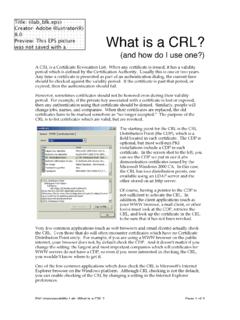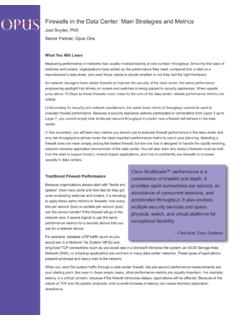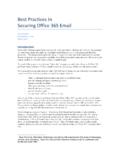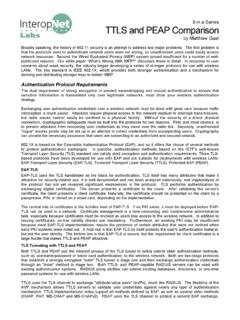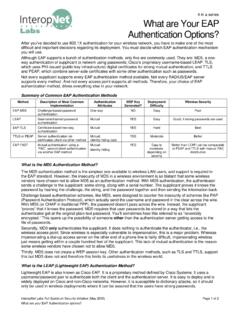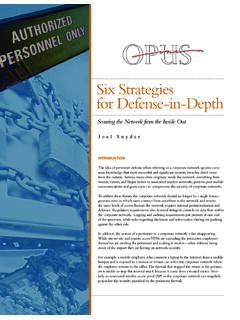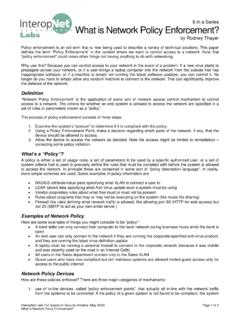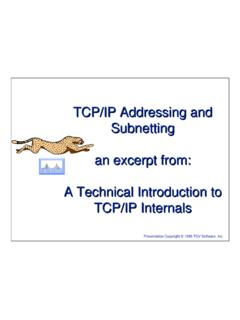Transcription of What’s Wrong With WEP? - opus1.com
1 5 in a seriesWireless LAN Security Interoperability Lab:Page 1 of 2 what s Wrong with WEP? what s Wrong with WEP?WEP is the privacy protocol specified in IEEE to provide wireless LAN users protection against casualeavesdropping. WEP stands for "Wired Equivalent Privacy" referring to the intent to provide a privacy service towireless LAN users similar to that provided by the physical security inherent in a wired WEP is active in a wireless LAN, each packet is encrypted separately with an RC4 cipher streamgenerated by a 64 bit RC4 key. This key is composed of a 24 bit initialization vector (IV) and a 40 bit WEP encrypted packet is generated with a bitwise exclusive OR (XOR) of the original packet and the RC4 IV is chosen by the sender and should be changed so that every packet won't be encrypted with the samecipher stream.
2 The IV is sent in the clear with each packet. An additional 4 byte Integrity Check Value (ICV) iscomputed on the original packet using the CRC-32 checksum algorithm and appended to the end. The ICV (becareful not to confuse this with the IV) is also encrypted with the RC4 cipher stream. WEP has been widelycriticized for a number of : Key Management and Key SizeKey management is not specified in the WEP standard, and therefore is one of its weaknesses, because withoutinteroperable key management, keys will tend to be long-lived and of poor quality. Most wireless networks thatuse WEP have one single WEP key shared between every node on the network. Access Points (APs) and clientstations must be programmed with the same WEP key. Since synchronizing the change of keys is tedious anddifficult, keys are seldom addition, the size of the key---40 bits---has been cited as a weakness of WEP.
3 When the standard was writtenin 1997, 40 bit keys were considered reasonable for some applications. Since the goal was to protect against"casual eavesdropping" it seemed sufficient at the time. The US did not tightly control exports of 40-bitencryption, and the IEEE wanted to ensure exportability of wireless standard does not specify any WEP key sizes other than 40 bits. Most vendors have implemented ade facto standard, simply extending the key size to 104 bits, with excellent interoperability. You will often see thiscalled 128-bit WEP key (because it sounds better than a 104-bit key), but that is not a fair comparison. This iswhy you enter 13 characters (or 26 hexadecimal digits) instead of 16 characters when you set up a long WEPkey.
4 In either case (40-bits or 104-bits), the RC4 encryption key includes a 24-bit IV (as described above).Obviously, 104-bit keys are more resistant to brute-force attacks than 40-bit keys. But brute-force attacks on 104-bit keys---which would take billions of years---are not considered the primary weakness of : The Initialization Vector (IV) is Too SmallWEP s IV size of 24 bits provides for 16,777,216 different RC4 cipher streams for a given WEP key, for any keysize. Remember that the RC4 cipher stream is XOR-ed with the original packet to give the encrypted packetwhich is transmitted, and the IV is sent in the clear with each packet. The problem is IV reuse. If the RC4 cipherstream for a given IV is found, an attacker can decrypt subsequent packets that were encrypted with the same IV,or, can forge packets.
5 This means that you don t need to know the WEP key to decrypt packets if you know whatthe key stream was used to encrypt that packet. They sound like similar problems, but it s actually much easier todiscover the key stream than it is to discover the WEP there are only 16 million IV values, how the IV is chosen makes a big difference in the attacks based on , WEP doesn t specify how the IV is chosen or how often the IV is changed. Some implementationsstart the IV at zero and increase it incrementally for each packet, rolling over back to zero after 16 million packetshave been sent. Some implementations choose IVs randomly. That sounds like a good idea, but it really isn' a randomly chosen IV, there is a 50% chance of reuse after less than 5000 , there are many methods for discovering the cipher stream for a particular IV.
6 For example, given twoencrypted packets with the same IV, the XOR of the original packets can be found by XORing the encryptedpackets. If the victim is on the Internet, the attacker can simply ping the victim or send an email message. If theattacker is able to send the victim packets and observe and analyze those encrypted packets, he can deduce thecipher in a seriesWireless LAN Security Interoperability Lab:Page 2 of 2 what s Wrong with WEP?Weakness: The Integrity Check Value (ICV) algorithm is not appropriateThe WEP ICV is based on CRC-32, an algorithm for detecting noise and common errors in transmission. CRC-32is an excellent checksum for detecting errors, but an awful choice for a cryptographic hash. Better-designedencryption systems use algorithms such as MD5 or SHA-1 for their CRC-32 ICV is a linear function of the message meaning that an attacker can modify an encrypted messageand easily fix the ICV so the message appears authentic.
7 Being able to modify encrypted packets provides for anearly limitless number of very simple attacks. For example, an attacker can easily make the victim s wireless APdecrypt packets for him. Simply capture an encrypted packet stream, modify the destination address of eachpacket to be the attacker s wired IP address, fix up the CRC-32, and retransmit the packets over the air to the AP will happily decrypt the packets and forward them to the attacker. (The attack is slightly more complexthan that, but to keep this paper short, we ve skipped some of the details.)The biggest problem with IV and ICV-based attacks is they are independent of key size, meaning that even hugekeys all look the same. The attack takes the same amount of : WEP s use of RC4 is weakRC4 in its implementation in WEP has been found to have weak keys.
8 Having a weak key means that there ismore correlation between the key and the output than there should be for good security. Determining whichpackets were encrypted with weak keys is easy because the first three bytes of the key are taken from the IV thatis sent unencrypted in each packet. This weakness can be exploited by a passive attack. All the attacker needsto do is be within a hundred feet or so of the of the 16 million IV values available, about 9000 are interesting to the most popular attack tool, meaning theyindicate the presence of weak keys. The attacker captures interesting packets , filtering for IVs that suggestweak keys. After that attacker gathers enough interesting packets, he analyzes them and only has to try a smallnumber of keys to gain access to the network.
9 Because all of the original IP packets start with a known value, it seasy to know when you have the right key. To determine a 104 bit WEP key, you have to capture between 2000and 4000 interesting packets. On a fairly busy network that generates one million packets per day, a few hundredinteresting packets might be captured. That would mean that a week or two of capturing would be required todetermine the best defense against this type of attack is not to use those weak IV values. Most vendors are nowimplementing new algorithms that simply do not choose weak IVs. However, if just one station on the networkuses weak keys, the attack can : Authentication Messages can be easily defines two forms of authentication: Open System (no authentication) and Shared Key are used to authenticate the client to the access point.
10 The idea was that authentication would be betterthan no authentication because the user has to prove knowledge of the shared WEP key, in effect, authenticatinghimself. In fact, the exact opposite is true: if you turn on authentication, you actually reduce the total security ofyour network and make it easier to guess your WEP Key authentication involves demonstrating the knowledge of the shared WEP key by encrypting achallenge. The problem is that a monitoring attacker can observe both the challenge and the encryptedresponse. From those, he can determine the RC4 stream used to encrypt the response, and use that stream toencrypt any challenge he receives in the future. So by monitoring a successful authentication, the attacker canlater forge an authentication.
